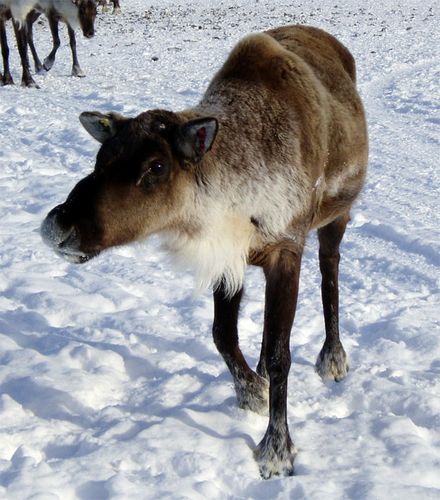Today was an action-packed day. We took a break from our training classes to go down to the river to see the finish of the Yukon Quest dog mushing race. I had been following the progress of the race online so I was really excited to get to see the finish. There were rumors that it would be a close race at the finish so we were all excited to get to see it.
 I am waiting for the dogs to come in at the finish line of the Yukon Quest race on the Chena River in Fairbanks, AK.
I am waiting for the dogs to come in at the finish line of the Yukon Quest race on the Chena River in Fairbanks, AK.
Here is a little background on the Yukon Quest race. The race covers a distance of 1,000 miles between Whitehorse, Yukon and Fairbanks, Alaska and follows the historic Gold Rush and Mail Delivery dog sled routes. The start and finish of the race switches every year between Whitehorse and Fairbanks and this year it started in Whitehorse and ended in Fairbanks. The route that the dogs follow crosses over four mountain ranges and follows the curving paths of frozen rivers. Don’t worry about the health of the dogs. There are several check points where veterinarians check on their health and the handlers treat the dogs really well. At the end, the dogs even looked a little disappointed that the race was over. Usually the racers have to deal with incredibly low temperatures and high winds, but this year it was unseasonably warm. The weather combined with the skill of the mushers and the endurance of the dogs led to this year’s record breaking time. The winner was Sebastian Schnuelle by four minutes over Hugh Neff. For winning the race, Schnuelle took home a prize of $35,000. To read more about the Yukon Quest check out www.yukonquest.com.
 The dog on the left was my favorite dog at the finish line. It had beautiful eyes.
The dog on the left was my favorite dog at the finish line. It had beautiful eyes.
An exciting part of the race was that I got to meet Lance Mackey. To many people he is considered to be a racing legend. He has won the Yukon Quest four times in a row between 2005 and 2008 and he won the Iditarod the last two years in a row. Even more amazing is that he was diagnosed with throat cancer in 2001 and he has fought back to beat the cancer and accomplish those great feats. He was a very down-to-earth guy and he was happy to talk to us. Check out the video below to see an interview with Lance Mackey and the finish of the first and second place teams.
http://
After the race we went to the ARCUS (Arctic Research Consortium of the United States) and had a great lunch. Everyone chipped in and made a wonderful potluck lunch of traditional Alaskan foods. I got to try moose and reindeer, which both tasted very good. I also had the best blueberry pie that I had ever tasted. It was awesome…yum I can still taste it when I think about it.
After lunch we went to the Large Animal Research Station (LARS) at the University of Alaska Fairbanks. The research station is home to several reindeer, caribou, and muskoxen. They are all part of different research projects but one project that I thought was pretty cool was one on the bacteria found in the rumen of the muskoxen. Muskoxen have incredible digestive systems which can make use of low quality food. Since food can be scarce for them at times, their digestive systems have evolved to use every bit of nutrient in their food. If you were to feed a cow from Michigan the same diet that a muskoxen could survive on, it would probably starve to death. They are using ports in the sides of the muskoxen, which allow the researchers direct access into their rumen, to test the bacteria in the rumen to see if it is what helps the muskoxen to be such efficient eaters. If you want to learn more about LARS, check out their website at http://www.uaf.edu/lars/index.htm.
 A reindeer striking a pose at the Large Animal Research Station in Fairbanks, AK.
A reindeer striking a pose at the Large Animal Research Station in Fairbanks, AK.
 A caribou checking me out at the Large Animal Research Station in Fairbanks, AK.
A caribou checking me out at the Large Animal Research Station in Fairbanks, AK.
 A muskox at the Large Animal Research Station in Fairbanks, AK (notice the port to its rumen in its side).
A muskox at the Large Animal Research Station in Fairbanks, AK (notice the port to its rumen in its side).
